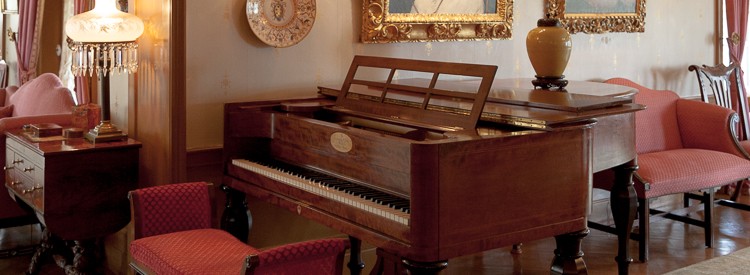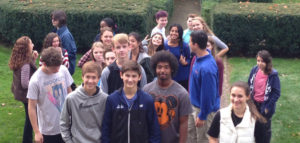Overview
 Les Peintures! Les Sculptures! Les Estampes!
Les Peintures! Les Sculptures! Les Estampes!
Students find a French connection in Farmington as they discover the exceptional collection of paintings, prints and sculptures created by French artists on display in situ at the museum. Featured artists include Claude Monet, Édouard Manet, Edgar Degas, Eugène Carrière, Henri Matisse, Jean-François Millet, Puvis de Chavannes, and Antoine-Louis Barye.
Learning Objectives
Students will learn about the Pope family’s 1888 to 1889 Grand Tour of Europe, where they acquired many of the French objects in the collection.
- Historical Connections: Students will discover associations between Hill-Stead — the American Colonial Revival house and estate designed by Theodate Pope Riddle, and the French culture of the late nineteenth century represented in the exceptional art collection showcased at the museum.
- Impressionism: Through observations and discussion of the nineteenth-century French art in Hill-Stead’s collection, students will explore, the influence Édouard Manet and the Impressionist painters had on the modern art movement. The painters will be explored as a group of daring artists who resisted the academic art style that conformed to the French Academy.
Collection Connections
Claude Monet
- Fishing Boats at Sea, ca. 1867-69
- View of Cap D’Antibes, 1888
- Grainstacks, White Frost Effect, 1889
- Grainstacks, In Bright Sunlight, 1890
Edgar Degas
Mary Cassatt
- Sarah Handing a Toy to the Baby, c. 1901
- Gathering Fruit, 1893
James McNeill Whistler
Pierre Puvis de Chavannes
Eugène Carrière
Édouard Manet
Antoine-Louise Barye
Jean-Francois Millet
Other objects from the collection
- Theodate’s diary entries related to her visits to Paris during her Grand Tour
- Archival documents, including receipts, letters and photographs
Other Resources
Key Artists and Figures
For more information on individual artists and painting, follow these links to the Our Collection section of our website.
- Antoine-Louis Barye (1796 – 1875): A French sculptor who inspired a school of animalier, or animal artists. Many of his bronzes depict wild beasts in combat. Alfred Pope collected eight bronze sculptures by Barye, including Lion and a Serpent.
- Felix Bracquemond (1833 – 1914): A French print maker credited with bringing Japanese ukiyo-e prints to the attention of the Impressionists. His etching, Gamecock, is in Hill-Stead’s collection.
- Eugène Carrière (1849 – 1906): A contemporary of the Impressionists, his work is associated with the Symbolist movement and has a soft, atmospheric quality meant to capture the essence of the model. Alfred Pope bought three works by Carrière: Head of a Woman with Flower, Child at Table, and Maternity.
- Mary Cassatt (1844 – 1926) : Although an American, Mary Cassatt settled permanently in France in the 1870s where she became friends with Edgar Degas and the other Impressionist painters, eventually exhibiting her work in several of the Impressionist Exhibitions. She met the Pope family in the late 19th century and became friends with Theodate. She visited Hill-Stead in 1908.
- Pierre Puvis de Chavannes (1824 – 1898): A French artist known for his murals and his influence on modern art. Alfred Pope purchased the oil painting, Peace, in 1894.
- Edgar Degas (1834 – 1917): Degas was famous for his paintings and pastels of dancers as well as jockeys and nudes. All three subjects are represented in Hill-Stead’s collection: Oil on Canvas: Dancers in Pink (oil on canvas), and The Tub and Jockeys (pastels on paper).
- Édouard Manet (1832 – 1883): Although Manet did not consider himself an Impressionist, he was a pathfinder in this avant-garde movement. Alfred Pope purchased two oils on canvas by Monet: Toreadors and The Guitar Player, along with an ink wash on paper, Absinthe Drinker.
- Charles Méryon (1821 – 1868): A French print maker known for his architectural scenes of Paris. The Pope collection includes three etchings including La Morgue.
- Jean-François Millet (1814 – 1875): One of the founders of the Barbizon school in France, Millet was best known for his paintings of peasants and landscapes from that area of Franch. His etching, The Gleaners, was made by the artist to promote an oil painting that now hangs in the Musée d’Orsay in Paris.
- Claude Monet (1840 – 1926): One of the best-known French Impressionist painters, Monet was known for his en plein air work. Alfred Pope purchased nine works by Monet, four of which remain in the collection: Fishing Boats at Sea, Grainstacks in Bright Sunlight, Grainstacks White Frost Effect, & View of Cap d’Antibes.
- Marie Antoinette (1755 – 1793): Marie Antoinette married the future French king, Louis XVI in 1770 and became Queen in 1774. A parlor clock in one of the bedrooms is styled after one she owned.
- Paul Durand-Ruel (1831 – 1922): A French art dealer who is associated with exhibiting the Impressionists. He sold a number of works to Alfred Pope.
- Jean-Jacques Rousseau (1712 – 1778): A philosopher of influence during the Enlightenment in eighteenth-century France. A portrait print of him hangs in the First Library.
- Voltaire (1674 – 1778): A writer during the Enlightenment in eighteenth-century France. A portrait print of him hangs in the First Library.
Vocabulary
For a printable vocabulary list, see Vocabulary for Bienvenue au Musée Hill-Stead.
- Academic art: Art that conforms to the standards of the French Academy, the official body that promoted traditional art based on classical ideals during the nineteenth century.
- Animalier: French; an artist who specializes in depicting animals.
- Artiste: French m/f; artist.
- Avant-garde: Artists or concepts of a strikingly new or radical nature for the time; before the group or vanguard.
- Chef d’oeuvre: A masterpiece, especially in art or literature.
- École des Beaux-Arts: The national school of fine arts in France, founded in 1671.
- En Plein Air: French; open air; painting out of doors.
- Estampes: French f, pl; prints.
- French Academy: The official, government-sponsored institution that controlled the arts in France, particularly during the 1800s. The Academy ran the École des Beaux-Arts and the yearly art exhibition known as The Salon.
- Genre Painting: A term used to categorize paintings depicting scenes of everyday life.
- Grand Tour: Initially, an extended tour of continental Europe considered a finishing course in the education of young men of the English upper class. Subsequently, wealthy Americans traveled by steamship to Europe to enjoy the arts, culture, shopping and fine dining.
- Impressionist art: A style of art, which developed around 1870, generally devoted to subjects of leisure, the upper-middle class, and the city rendered in a naturalist manner often painted directly before nature, en plein air. A style known for its sketch-like brushwork and simplified forms, leaving the viewer with an “impression” of a scene rather than an immensity of detail, and a lack of traditional finish. Typically, this work is characterized by short brush strokes of bright colors in immediate juxtaposition to represent the effect of light on objects.
- In Situ: A Latin phrase that translates to “on site” or “in position” and at Hill-Stead, refers to artwork placed in a home setting as it would have been enjoyed by the Pope family.
- Marine: French f; a seascape.
- Objet d’art: French m; work of art
- Palette: The thin board or slab on which an artist lays and mixes colors; also, the range of colors used in a particular picture.
- Peintures: French f, pl; paintings
- Provenance: The history or ownership of a work of art from the time of its creation to the present.
- Salon: The official annual art exhibition in Paris first established in the seventeenth century by the French Art Academy.

